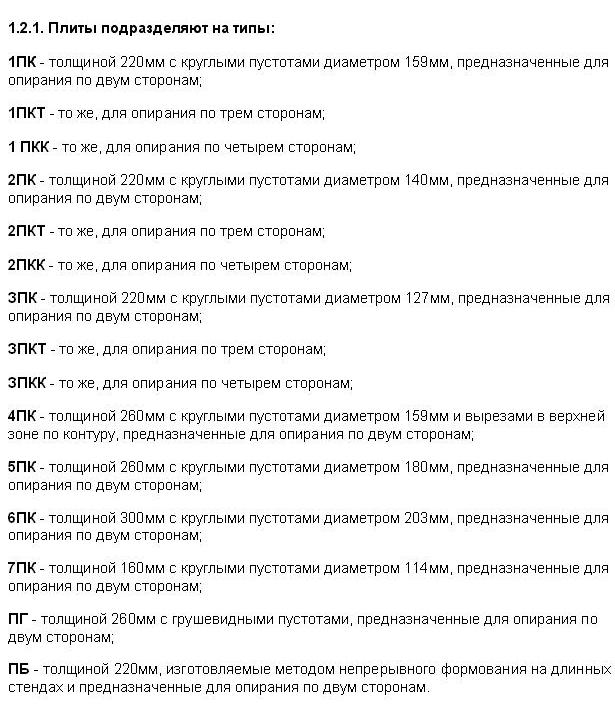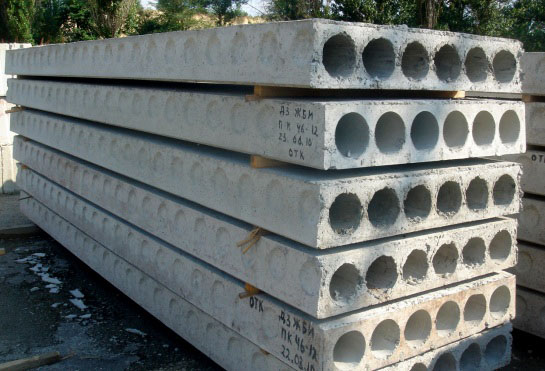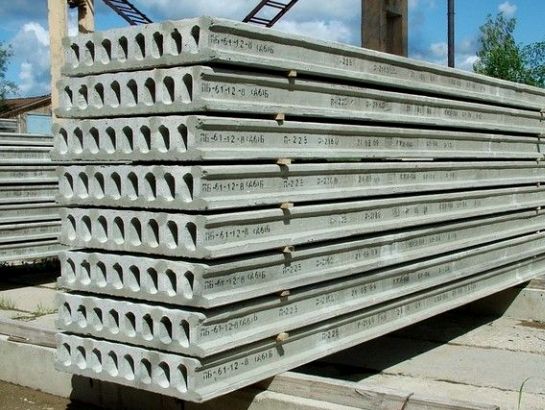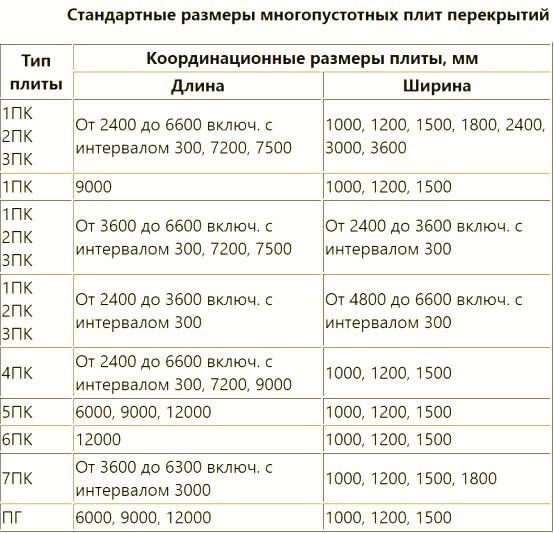Floor slabs: types and marking according to GOST, characteristics, sizes and prices
Looking at the stacks of reinforced concrete slabs, an ordinary citizen does not suspect how much important information they can provide to a specialist builder. This is not surprising, because in everyday life we rarely encounter such structures.
If we are talking about a new building, then it will be useful for the customer of installation work to know what types and sizes of floor slabs exist, as well as what is their maximum bearing capacity according to GOST.
At first glance, the differences between hollow core slabs are only in their length, thickness and width. However, the technical characteristics of these structures are much more extensive, so we will consider them in more detail.
State standard - a set of laws of strength
All basic requirements for hollow core slabs, including their purpose and strength characteristics, describes GOST 9561-91.
First of all, it indicates the gradation of the plates depending on their thickness, the diameter of the holes and the number of sides with which they rest on the walls.

In addition to different thicknesses and geometric dimensions, hollow core slabs are classified according to the method of reinforcement. GOST specifies that panels that rest on walls on 2 or 3 sides must be made using prestressed reinforcement.
The practical conclusion that follows from this for the developer is that it is impossible to punch holes for engineering communications, violating the integrity of the working fittings. Otherwise, the slab may lose its bearing capacity (crack under load or collapse).
Paragraph 1.2.7 of GOST 9561-91 makes important exceptions, allowing the manufacture of certain types of plates not to put prestressing reinforcement in them.
They belong to the following panels:
- 220 mm thick with a length of 4780 mm (voids with a diameter of 140 and 159 mm);
- Thickness 260mm, length less than 5680mm;
- Thickness 220 mm, any length (voids with a diameter of 127 mm).
If such reinforced concrete floor slabs were brought to your facility, and non-tensioned reinforcement is indicated in their passport, do not rush to send the car back to the factory. These designs comply with building codes.
Features of manufacturing technology
Floor slabs are made in different ways, which is reflected in the quality of their front surface. Plates of PK and PG grades are cast in formwork, and PB panels are made in a continuous way on a conveyor line. The latest technology is more perfect than formwork manufacturing, so the surface of PB boards is more even and smooth than that of PK and PG boards.
In addition, conveyor production allows you to make PB slabs of any length (from 1.8 to 9 meters). This is very convenient for the customer when it comes to the so-called "additional" slabs.
The fact is that when laying out plates on a building plan, several sections are always formed where standard panels do not fit. Builders get out of the situation by filling such "white spots" with monolithic concrete right on the site. The quality of such a home-made design is noticeably inferior to that achieved in the factory (vibration compaction and steaming of concrete).

The advantage of PK and PG boards over PB panels is that it is possible to punch holes in them for communications without fear of destruction of the structure. The reason is that the diameter of their voids is at least 114 mm, which allows you to freely pass the sewer riser (80 or 100 mm in diameter).

For PB plates, the holes are narrower (60 mm). Therefore, here, in order to skip the riser, it is necessary to cut the rib, weakening the structure. Experts say that such a procedure is unacceptable only for high-rise construction. When erecting low-rise housing, punching holes in PB slabs is allowed.
Advantages of hollow reinforced concrete slabs
There are many of them and they are all quite significant:
- Reducing the weight of building structures;
- The voids in the slabs dampen vibrations, therefore, such an overlap has good sound insulation;
- The possibility of laying communications inside the voids;
- Fire resistance and moisture resistance;
- High speed of installation work;
- Durability of the building.
Dimensions of hollow core slabs
Here, everything is unified to the maximum so that it is possible to manufacture a structure of any mounting size. The gradation of the width and length of the plates comes in increments of 100 to 500 mm.

Marking - floor slab passport
The developer does not need to know the intricacies of the technology used to manufacture a multi-hollow slab. It is enough to learn how to correctly decipher the marking.
It is performed in accordance with GOST 23009. The slab brand includes three alphanumeric groups separated by hyphens.
The first group contains data on the panel type, its length and width in decimeters (rounded to the nearest whole number).
The second group says:
- The bearing capacity of the slab or the design load (kilopascals or kilogram-force per 1 m2);
- For prestressed slabs, the class of reinforcing steel is indicated;
- Type of concrete (L - light, C - silicate, heavy concrete is not indicated in the marking).
The third group in the marking contains additional characteristics that reflect the special conditions for the use of structures (resistance to aggressive gases, seismic effects, etc.). In addition, the design features of the plates are sometimes indicated here (the presence of additional embedded parts).
As an example explaining the principle of marking hollow core panels, consider the following design:
Hollow panel type 1PK, length 6280 mm, width 1490 mm, designed for a load of 6 kPa (600 kg / m2) and made of lightweight concrete using prestressing reinforcement class At-V).
Its marking will look like this: 1PK63.15-6AtVL. Here we see only two groups of characters.
If the slab is made of heavy concrete and is intended for use in a seismically hazardous area (seismicity up to 7 points), then the third group of symbols appears in its designation: 1PK 63.15-6АтV-С7.
The considered technical characteristics of floor slabs determine the scope of their application.
All types of multi-hollow panels are calculated based on the normative floor load - 150 kg / m2 (weight of people, equipment and furniture).
The bearing capacity of a standard board is in the range of 600 to 1000 kg/m2. Comparing the standard of 150 kg/m2 with the actual strength of the panels, it is easy to see that their safety margin is very high. Therefore, they can be laid in all types of residential, industrial and public buildings.
|
Plate type |
Reduced plate thickness, meters |
Average density of concrete slab, kg/m3 |
Plate length, meters |
Building characteristics |
| 1PC,1PCT, 1PCC |
up to 7.2 inclusive |
Residential buildings (sound insulation of premises is provided by the installation of floating, hollow, hollow or layered floors, as well as single-layer floors on a screed | ||
| 1pc | ||||
| 2PCS, 2PCT, 2PCC | Residential buildings in which the sound insulation of residential premises is provided by the installation of single-layer floors | |||
| 3PCS, 3PCT, 3PCC | ||||
| 4pcs | Public and industrial buildings | |||
| 5pcs | ||||
| 6pcs | ||||
| PG | ||||
| 7pcs | Residential buildings (low-rise and estate type) |
This table contains the given thickness of the slab - a term not understood by beginners. This is not the geometric thickness of the panel, but a special parameter created to evaluate the cost-effectiveness of the panels. It is obtained by dividing the volume of concrete laid in the slab by its surface area.
Estimated prices
During construction, dozens of standard sizes of hollow core slabs are used, so a separate article would have to be devoted to a detailed description of their prices. We will indicate the price parameters of the most "running" panels (self-delivery):
- PK 30.12-8 - from 4,800 rubles / unit;
- PK 30.15-8 - from 5,500 rubles / unit;
- PK 40.15-8 - from 7,600 rubles / unit;
- PK 48.12-8 - from 7,000 rubles / unit;
- PK 51.15-8 - from 9,500 rubles / unit;
- PK 54.15-8 - from 9,900 rubles / unit;
- PK 60.12-8 - from 8,200 rubles / unit;
- PK 60.15-8 - from 10,600 rubles / unit;
Installation of hollow core slabs
The main condition for the high-quality installation of panels is strict observance of the calculated parameters of support on the walls. Insufficient support area leads to the destruction of the wall material, and excessive - to increased heat loss through cold concrete.
Installation of floor slabs must be carried out taking into account the minimum allowable support depth:
- on a brick - 90 mm;
- for foam concrete and aerated concrete blocks - 150 mm;
- on steel structures - 70 mm;
- for reinforced concrete - 75 mm;
The maximum depth of embedding slabs into walls should not exceed 160 mm (brick and light blocks) and 120 mm (concrete and reinforced concrete).
Before installation, each slab must be filled with voids (with lightweight concrete to a depth of at least 12 cm). Laying the panel "dry" is prohibited. For uniform load transfer on the walls, a mortar “bed” with a thickness of no more than 2 cm is spread before laying.

In addition to observing the standard support depths, when installing floor slabs on fragile blocks of their gas or foam concrete, a monolithic reinforced concrete belt should be laid under them. It eliminates the punching of blocks, but requires good external insulation to eliminate cold bridges.
During the installation process, the deviation of the difference in the marks of the front surfaces of adjacent panels should be constantly monitored. You need to do this in the seams. Don't listen to the builders who put the panels in "steps" and tell you that it's impossible to lay them evenly.
Building codes establish the following tolerances depending on the length of the slabs:
- up to 4 meters - no more than 8 mm;
- from 4 to 8 meters - no more than 10 mm;
- from 8 to 16 m - no more than 12 mm.
